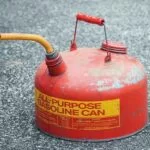Are Nitro RC Cars Bad for Environment (EcoFriendly Guide)

Nitro RC cars are not your regular battery-operated cars. They are hobby-grade RC cars run by gas-powered engines.
Compared to electric RC vehicles, nitro RC’s are bigger, faster and offer RC hobbyists a more realistic experience. However, they can cause some environmental hazards when misused, especially when disposing of the nitro fuel and the smoke the engine emits.
If you have a nitro RC car, here’s all you need to know about how your nitro RC interacts with the environment.


Are Nitro RC Cars Bad for the Environment
As mighty as nitro RC vehicles are, they come with their fair share of downsides, too, one of which is they are bad for the environment when it concerns their toxic smell and loud engine.
Nitro cars can only run on nitro fuel, which invites a foul smell and smoke from the exhaust when burnt. Plus, since it uses a race engine, you hear a loud sound that can inconvenience others.
How Toxic Is Nitro Fuel
Like any vehicle fuel, Nitro fuel doesn’t last forever; hence whether the fuel is sitting in its can or your RC vehicle, it will eventually go bad with time, and your car won’t work properly. Apart from this, nitro fuel is also quite toxic to the health.
Nitro fuel is a methanol-based fuel gotten from combining nitromethane and oil. On average, the fuel contains over 10% of nitromethane; it could also exceed this number to be around 20% to 40%.
However, this explosive chemical component, ‘nitromethane,’ which contains nitrogen and oxygen, is believed to cause cancer and is less friendly to the health due to the oxygen content. Yet, there is very little harm in using nitro fuel for your nitro RC car.
The only harm is when you inhale the methanol vapors in less-concentrated doses.
If, by mistake, the methanol spills, especially during the hot climate, it immediately starts to vaporize. The vapor can be inhaled and is also highly flammable. Tin daylight, this vapor is virtually impossible to see, so you have no idea you’re inhaling the vapor in your lungs. This can cause unexpected and severe internal damage. This means that nitromethane is very poisonous and toxic in its pure form.
So, if you’re wondering how toxic nitro fuel is, know that it’s only the unburnt fuel that is highly toxic.
Is RC Nitro Fuel Bad for the Soil\Earth
Nitro fuel is as damaging as petrol;
But, since the quantity of nitro fuel used in your RC car is a lot lesser than petrol used in vehicles, it isn’t a concern when it comes to the earth. The small fuel levels won’t have any real impact on the soil.
How Toxic Is Nitro Smoke
A Typical RC fuel container will have instructions like:
“May be fetal, cause blindness if ingested. If swallowed drink 1 or 2 cups of water and call poison control immediately. Vapors are extremely harmful. If contact with eyes is made, flush eyes for 15 minutes.”
But, it’s not just about ingesting the unburnt stuff and its vapor. Nitro smoke is not as toxic as when you inhale the unburnt fuel. When burnt in your RC engine, the exhaust will gain a high concentration of carbon monoxide, just like in real cars, which is visible as smoke. Unless you inhale this smoke in concentrated doses for a prolonged time and in a closed space, you risk causing common side effects like severe headaches and dizziness.
This means that there is very little harm to Inhaling nitro fuel in its burnt form. Nitro smoke becomes toxic when you ingest it for a long time.
Is Nitro Fuel Bad for You
Nitro fuel is extremely dangerous. It is flammable and known to be a leading cause of cancer.
When burning nitro fuel, you don’t have to worry about inhaling the vapor with a face mask on. However, nitro fuel can be bad for you when inhaled for longer hours, in substantial doses, and in closed space.
Does Nitromethane Affect Your Health
Nitromethane, chemically known as CH3NO2, is an explosive compound that contains nitrogen and oxygen. Apart from this, 65%-75% of its chemical compound comprises methanol, which is wood alcohol.
Methanols are known to cause blindness when ingested. Likewise, any alcoholic content has a high viscosity, and since methanol is wood alcohol, it evaporates rapidly and is responsible for the airborne vapors in nitro fuel.
When inhaled in concentrated doses, this vapor can cause severe damage to the health. Why? Nitromethane is poisonous in its pure form. The good news, it has an evaporative rate close to that of water. Hence, in its diluted form,10-40% in fuels, the amount of airborne nitromethane is very low.
When burned during a race, the most dangerous thing you may smell or inhale is carbon monoxide, which the engine produces.
So basically, if you don’t inhale nitromethane in concentrated form, in a closed garage, and for a long time, nitromethane won’t affect your health.
How to Dispose of Bad Nitro Fuel
It’s easy to store your nitro fuel, but disposing of them can be a hassle. Nitro fuel contains alcohol, nitromethane, and oil. The alcohol and nitromethane may evaporate, but the 18% oil won’t, and it will remain on the soil as a pollutant.
The best way to dispose of nitro fuel will be to find a proper hazardous waste disposal site where you won’t harm anything in the environment. Alternatively, you can pour the fuel into a can and sun it. When the methanol and nitromethane evaporate, take the leftover oil and pour it into waste oil disposal at the local tip or garbage dump.
Is There a Filter for Your Nitro RC Exhaust
Every RC car has an exhaust pressure line that uses pressure waves from the pipe to pressurize the fuel tank and feed fuel to the carburetor. Sometimes, you can get some debris from the pipe into your fuel tank through this line, and the hot exhaust gases will warm up your fuel and lessen the engine’s performance.
For this reason, you need to install a fuel filter in line with the exhaust pressure line that will catch any debris in the line, and the aluminum from the fuel filter will lower the dirt going into the fuel tank, keeping the nitro fuel cool. Some nitro RC exhaust filter models you can get in the market include:
- Yiju RC Nitro Engine Air Filter 74033-13
- Traxxas 5262 High-Volume Air Filter
- Colcolo RC Model Air Filter 74033-13 KE15SP
How Can You Make Your Nitro RC More Environmentally Friendly
Your Nitro RC car will only prove harmful to your health when they lack proper maintenance. To keep your nitro RC more environmentally friendly, make sure to:
- Get rid of the fuel
You want to always make sure to dispose of old and bad nitro fuel. This way, the nitro engine can perform well while keeping the air free from burnt nitro fumes. Plus, you won’t have to run the risk of mixing fresh fuel with the bad ones.
- Clean the engine case
Before pouring a new fuel, make sure to clean the engine case since it might hold some amount of harmful carbon monoxide.
- Remove stubborn particles
Get a small brush to remove small stubborn debris that might have passed through the fuel filter. Once you finish cleaning the engine, remove the plug and duel filter to keep away additional dirt.
- Clean the air filter
The next thing to do is to clean the air filter. Use a dishwashing liquid and warm water to keep the equipment clean as possible.
Should You Move to an Electric RC Car if You Care About the Environment?
While many people may feel that electric RC’s are more environmentally friendly than nitro cars, the truth is that in some respects, electric vehicles can be as bad as nitro RC vehicles.
Because of the complex batteries they use to power the motor, it takes more energy to run and maintain an electric car than a nitro. Moreover, disposing of those batteries creates an environmental hazard, just like nitro fuels.
For this reason, it’s best to learn how to make your nitro RC more environmentally friendly than moving to an electric RC car.
Conclusion
Nitro cars are powerful and last longer when maintained properly., especially as they run on nitro fuel. Plus, regular maintenance ensures they stay environmentally friendly. Regardless of this, RC hobbyists will risk their health running a nitro RC car when they fail to take precautions when disposing and burning the toxic nitro fuels.





